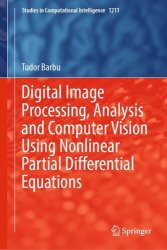Digital Image Processing, Analysis and Computer Vision Using Nonlinear Partial Differential Equations
- Добавил: literator
- Дата: 15-05-2025, 17:04
- Комментариев: 0
 Название: Digital Image Processing, Analysis and Computer Vision Using Nonlinear Partial Differential Equations
Название: Digital Image Processing, Analysis and Computer Vision Using Nonlinear Partial Differential EquationsАвтор: Tudor Barbu
Издательство: Springer
Серия: Studies in Computational Intelligence
Год: 2025
Страниц: 164
Язык: английский
Формат: pdf (true), epub
Размер: 54.5 MB
This book provides an overview of the applications of partial differential equations (PDEs) to image processing, analysis, and Computer Vision domains, focusing mainly on the most important contributions of the author in these closely related fields. It addresses almost all the PDE-based image processing and analysis areas, and the connections between partial differential equations, Computer Vision, and Artificial Intelligence (AI): PDE-based image filtering, inpainting, compression, segmentation, content-based recognition, indexing and retrieval, and video object detection and tracking, energy-based (variational) and nonlinear diffusion-based models of second and fourth order, nonlinear PDE-based scale-spaces in combination to convolutional neural networks and high-level descriptors to perform edge and feature extraction.
The book is composed of seven chapters, this introduction representing the first of them, and a section of references. The second chapter surveys the nonlinear PDE-based image denoising and restoration techniques. The PDE-based filtering of the additive white Gaussian noise (AWGN) is considered in its first section. The most important total variation (TV)-based and second- and fourth-order anisotropic diffusion-based AWGN removal solutions, including our own nonlinear parabolic and hyperbolic PDE-based AWGN-based filters, are described here. While signal-independent AWGN represents the most popular type of image noise, many digital images are contaminated by signal-dependent quantum (Poisson, shot) noise, resulting from fluctuations in the number of detected photons, or mixed Poisson-Gaussian noise during the acquisition process. Nonlinear PDE-based filtering models dealing with these types of noise are presented in the next two sections. The variational PDE, hyperbolic PDE and nonlinear anisotropic diffusion models developed by us for photon-limited image restoration and mixed noise filtering constitute the main focus of these sections. Some stochastic differential equation (SDE)-based models that lead to nonlinear PDE-based Gaussian, quantum and mixed noise reduction filters are also presented in these sections.
Next chapters treat the connection between the nonlinear PDEs and the Artificial Intelligence (AI), demonstrating how the PDE + AI combination represents an useful tool for solving numerous image analysis and computer vision tasks. The third chapter is dedicated to two closely related domains, which are the PDE-based inpainting and image compression. The inpainting, also called image interpolation or completion, is also strongly related to image restoration, since the inpainting domain, which is composed of the missing regions of a digital image, can be interpolated by directing the denoising process to it. Thus, the nonlinear PDE-based filtering models could be adapted for this reconstruction task by adding inpainting masks to them.
While the detection of the object instances in the video frames is performed by combining several Machine Learning and Deep Learning models, such as the GMM, SVM + HOG and Aggregate Channel Features (ACF) for moving persons, and GMM, ACF, YOLO networks and Faster R-CNN for vehicle detection, their instance-matching based tracking-by-detection (TBD) involves a high-level nonlinear PDE-based multi-scale analysis of the sub-images of the detected objects. The scale-space representations are created by applying the numerical solvers of some nonlinear second- and fourth-order reaction–diffusion models on those sub-images at some properly chosen iteration moments. The high-level feature extractions performed at multiple scales use combinations of Machine Learning and Deep Learning models, such as the mixtures of SURF and HOG-based descriptors, Inception-V3 and ResNet-101 convolutional neural networks, and the deep networks ResNet-50 and MobileNet-v2 respectively. Effective tracking-by-detection algorithms using the computed high-level feature vectors are provided in each case.
Скачать Digital Image Processing, Analysis and Computer Vision Using Nonlinear Partial Differential Equations
[related-news] [/related-news]
Внимание
Уважаемый посетитель, Вы зашли на сайт как незарегистрированный пользователь.
Мы рекомендуем Вам зарегистрироваться либо войти на сайт под своим именем.
Уважаемый посетитель, Вы зашли на сайт как незарегистрированный пользователь.
Мы рекомендуем Вам зарегистрироваться либо войти на сайт под своим именем.
